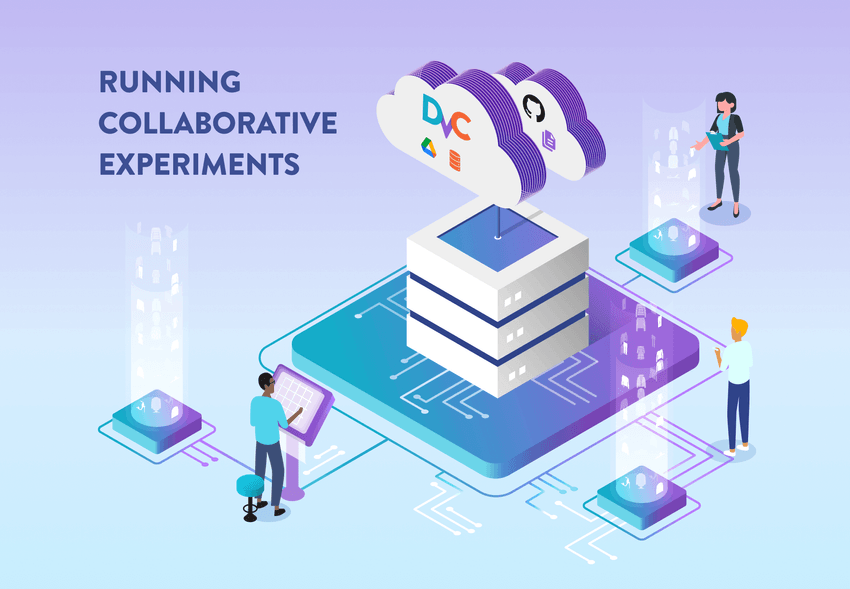
Running Collaborative Experiments
Intro
Sharing experiments to compare machine learning models is important when you're working with a team of engineers. You might need to get another opinion on an experiments results. You might need to share a modified dataset or even share the exact reproduction of a specific experiment.
Setting up DVC remotes in addition to your Git remotes lets you share all of the data, code, and hyperparameters associated with each experiment so anyone can pick up where you left off in the training process. We'll go through an example of sharing an experiment with DVC remotes.
Forking the project
To follow along, fork this repo as one of your own GitHub repos. That way you'll have pull access when we start working with DVC. This repo has different tags that show the progression of the project and you're welcome to check them out!
To get the branch we'll use in this post, you can run this command to clone your
forked repo. Make sure to replace <your_github> with your GitHub name.
$ git clone [email protected]:<your_github>/example-dvc-experiments.git -b get-startedThis project already has DVC files set up to run experiments, but if you want to follow along with a project you're currently working on, make sure to check out the steps to initialize a DVC pipeline in the Getting Started doc.
Setting up your DVC remotes
When you want to share the progress you've made with training your model, that usually means you need to find a way to bundle the code, data, and hyperparameters. This could be a complicated process if you're working with GBs worth of data or you have a large number of hyperparameters.
That's one of the uses for DVC and why we'll be working with remotes. To start with, make sure your GitHub remote is configured correctly. It should use the SSH version of the URL. This is so DVC can authenticate the pushes and pulls from GitHub it needs as part of experiment sharing.
The way DVC works is by storing custom Git refs in your repo with metadata that defines the experiment. You can learn more about how DVC uses custom Git refs in this post.
Next, you'll need to set up a remote to your data location. This could be an AWS S3 bucket, a Google Drive, or one of the other supported storage types.
An important thing to note about the project we're working with is that there is
already a remote set up for you to pull from. You can see this in .dvc/config.
You'll need to set up a separate remote to push changes to since this remote
doesn't allow push access.
For this example, we'll be using a Google Drive folder as the remote to handle pushing data. Now that you know what we're doing, let's run the command to set up the DVC remote to push to.
$ dvc remote add cloud_remote gdrive://1k6aUYWphOulJlXgq4XbfKExWGyymTpElThis adds the remote storage named cloud_remote for DVC to track and we'll be
able to push and pull the exact code and data to reproduce any experiment. With
your Git remote and DVC remotes in place, you can start pulling data and
experiments from the cloud to your local machine.
Note: Make sure you have write permissions to the Git remote!
Listing your remote experiments
When you're working with a team on an existing project, you might want to see the experiments already in the remotes so you know what's available. To take a look at the experiments we have run in the repo you forked, you'll have to set up a new Git upsteam remote to reference the original repo. You can do that with the following command.
$ git remote add upstream https://github.com/iterative/example-dvc-experimentNow you can take a look at all of the experiments we have associated with this repo with the following command.
$ dvc exp list upstream --allYou'll get a list of all of the experiments across different Git branches that have been pushed with DVC in the original repo. The output will look similar to this.
21784fa:
exp-c8dcf
main:
exp-b3667
exp-d382aNow you'll be able to pick which experiment you want to reproduce and start testing with.
Pulling experiments
If you're picking up an existing project, there will likely be a specific experiment you'll get started with. To pull an experiment to your local machine, you'll need an experiment id for the following command.
$ dvc exp pull upstream exp-b3667The exp-b3667 comes from the dvc exp list command we ran earlier and now you
have all of the data and code associated with that experiment on your machine.
From here, you can start running new experiments with different models, hyperparameters, or even datasets.
Pushing experiments
Once you're done with your new experiments, you can push these to the Google Drive remote we set up earlier. DVC handles both the GitHub and data storage pushes with this command.
$ dvc exp push origin exp-p4202This will push the custom Git refs to your forked repo and it will push any artifacts, like your data or model output, to the DVC remote location. If you have checkpoints enabled, it will also push the checkpoints of an experiment. Now you can easily share your work with other engineers to get feedback faster and finish projects sooner.
Conclusion
It's a lot easier to get help from someone on a project when you can share everything with them. When you use DVC, you can bundle your data and code changes for each experiment and push those to a remote for somebody else to check out.
